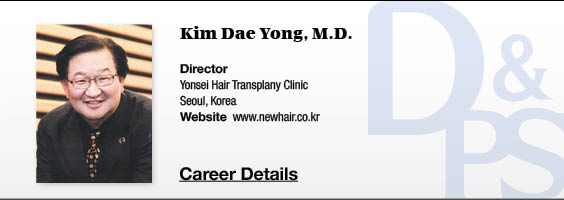
▶ Previous Artlcle: http://1-2-various-hair-transplant-methods
Trichophytic Suture
The author will introduce a new device to peel off a very thin trichophytic strip to ensure a easier, quicker trichophytic suture.
The neck part of a 5cc syringe is transected with a PVC pipe cutter that can be sterilized via an autoclave, so that it can be used as a handle. A razor blade that is cut in half and bent is pushed into the syringe of which neck part was cut off and than is fixed to the inner wall of the syringe.
When the trichophytic strip is peeled off, a skin hook is used to stretch the skin. In this case, the assistant need to pull the skin hook in the opposite direction.
A tension must be applied to the area where a trichophytic strip will be peeled off, to ensure that a thinner trichophytic strip can be certainly peeled off. Thus, the author divided the section for stretching the skin using the skin hook at the border of the area below the scar at the donor site into three to four areas.
If such tension is applied while using a trichophytic tool, a thin strip will be peeled off, thereby reducing additional damage to the tissue of the donor site. In addition, if the depth when peeling off a trichophytic strip is maintained at 0.5mm or less, any events that may occur after trichophytic suture, such as serious inflammation, pustules, and cysts, can be prevented by leaving the sebaceous gland unharmed while stopping the drainage of sebum from being blocked.
There is a condition to produce a satisfying result for the trichophytic suture conducted by the author. It is a double suture which involves the primary conduct of a suture encompassing entire layers of the dermis and the subcutaneous fat using Vicryl 4-0, followed by the secondary skin closure using Nylon 4-0.
In the case of trichophytic suture, the space between sutures should be narrowed to 2~3mm compared to the existing suture technique. In addition, it should be continuously checked, during a suture, if the upper side of the scar at the donor site is well matched to the lower side where the epidermis is transected.
[Ad. ▶ COPPER BROMID(Yellow/Green Laser) – Manufacturer: BISON(www.bisonmedical.com)]
Asymmetric Dermal-subdermal Suture
When a double suture is performed to minimize the scar at the donor site, the depth to which a needle is inserted is different between the upper and lower sides of the scar at the donor site during a suture encompassing entire layers of the dermis and the subcutaneous fat, intentionally making an asymmetric dermal-subdermal suture as if forming a stratification.
In other words, the upper interface is raised by 2mm compared to the lower side to obtain an available skin tissue. Thus, the galea layer's stretch-back, reminiscent of a spring returning to its original position, which is considered to be the root of tension on the epithelial tissues, is fixed to the knot of the subdermal suture, and continuous skin sutures with no tension also becomes possible, maximizing the results of trichophytic suture.
- To be continued




















